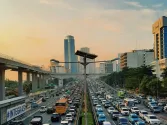
What will drive faster economic growth in emerging ASEAN markets
The young population and the middle class will help boost the economy.
Emerging markets in Southeast Asia can expect faster economic growth on the back of several factors including the increasing middle class amongst others, with consumption in some major cities exceeding those from Western countries.
Lan Ha, head of Economics at Euromonitor International, said the easing of COVID-19 restrictions, improved labour market and improved spending, will accelerate the expansion of the economy in the region.
However, she flagged that Russia’s invasion of Ukraine led to a surge in commodity prices and dampened the economic activities of major economies and had a spillover effect on emerging markets in the region such as inflation, supply disruption, and lower demand for export. Ha also noted that monetary tightening by the US and other markets would hamper foreign investment inflows.
“Despite all those downside risks, we still forecast that Vietnam, Thailand, Indonesia, and the Philippines' economies would see a quicker economic recovery this year and next year. The short and medium-term outlook seems to be brighter than major key economies,” Ha said.
“In the long term, we also project emerging ASEAN economies to continue the strong growth trajectory,” she added.
The economic growth of the Philippines, Vietnam, Indonesia, and India will be faster than China in the next 20 years, partly driven by China’s economy becoming more mature and its waning catch-up potential, she said.
Driving factors
Emerging markets’ economic growth is mainly driven by four major factors namely: demography, the middle class, technology, and urbanisation, Ha said.
The developing markets in the region especially the Philippines, Vietnam, and Indonesia will benefit from the demographic dividend with the young population. She noted that the median age in the region was between 25 to 33 years old in 2021, younger than 43 in developed countries.
“A younger demographic means the region will continue to enjoy strong labour supply, and this has to drive productivity gain and consumption growth,” she said.
The growing middle class will also contribute to driving medium and long-term growth, and boost consumer spending and attract investments, Ha said, noting that the emerging ASEAN economies will add over 10 million middle-class households between 2021 to 2040.
The region is also known for its fast digital transformation, supported by the young and tech-savvy population. Over nine in 10 households will have internet access by 2040 in Indonesia, Thailand, and Vietnam.
“Rapid technology adaptation and digital innovation will help facilitate economic activities and boost productivity growth in the region,” she said.
Another strong driver would be urbanisation which would support investment, education, and consumption growth. The region will see an additional 112 million people move to urban areas between 2021 to 2040.
From 2000 to 2021, the emerging markets in the region added 140 million urban consumers, only behind China and India. For this year, the urban population is expected to surpass the rural population, the first time it is recorded, said Fransua Vytautas Razvadauskas, head of Cities Research at Euromonitor.
By 2040, the emerging ASEAN’s urban population will reach 450 million, accounting for around 11% of the world’s population.
However, he noted that the rate of urbanisation in the region varies, citing Myanmar with only 32% of the population in urban areas in 2021, compared to 58% in Indonesia.
Razvadauskas also said that the emerging markets in the region are “frontrunners in income and economic growth,” adding that the urban disposable incomes will more than double from 2021 to 2040 due to rapid economic growth.
“Indeed, rising income growth in tandem with growing urbanisation is expected to make the ASEAN region a major hub for consumption in the future,” he said.
Opportunities, challenges
The economic growth potential has presented areas for opportunities the emerging markets can leverage such as the diversification of the supply chain.
Ha said the pandemic sped up the moves made by global businesses to shift to more local and regional production to limit the complexity and become closer to end-consumers, which will benefit the ASEAN market.
She noted China is a major production spot, but the high concentration there has proven to be vulnerable for global manufacturing and it is affected by its trade war with the US. Apple for example shifted part of its iPad production to Vietnam whilst Hyundai relocated some production to Indonesia.
Emerging markets can also tap into new trade agreements such as the Regional Comprehensive Economic Partnership that will help increase their presence in the regional and global value chains. The increasing disposable income will also lead to the development of a new middle class with larger spending capabilities, she said.
Razvadauskas added that some key ASEAN cities will overtake some Western economies in consumer expenditure by 2040. For example, Bangkok's consumer expenditure in 2021 was at $130b and will reach $223b in 2040, exceeding Madrid and Berlin.
Manila, meanwhile, will see its expenditure grow from $116b in 2021 to $343b in 2040, surpassing Sydney at $281b in 2040, and trailing behind Paris at $387b.
However, Ha said the region faces a challenge in productivity growth noting that Indonesia’s, Thailand’s, Philippines’ and Vietnam’s productivity was around 10 times lower than the developed country average in 2021.
“We need to invest more in infrastructure but also education and training in order to boost labour productivity. A shift from labour intensive to high value-added manufacturing will also be important in sustaining the region's high performing status in the long term,” she said.
She added that the markets remain “vulnerable to global and financial and economics shocks” as well as to climate impact. Ha said they also need to invest in decarbonisation to achieve net-zero targets by some countries from 2050 to 2060.
Razvadauskas also cited challenges in urban areas such as overcrowding high population densities, income inequality as some segments of the population may get left behind when the economy grows, and some environmental challenges such as flooding.
To realise the economic growth potential, emerging markets should cater to the evolving consumer demands and harness urban growth. They should have a diverse supply chain and ensure flexibility and agility in dealing with volatilities, they said.














